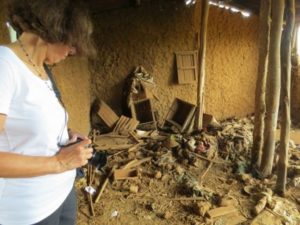The JWW team traveling to eastern Congo has begun their trip in neighboring Rwanda. It’s an important time to visit the country, which this year marked the 20th anniversary of the genocide that killed nearly a million civilians in only 100 days. The team spent Monday, July 21 in and around Kigali, visiting genocide memorial sites in the area, speaking with survivors and — as our mission compels us to do — bearing witness to their stories of atrocities, survival, forgiveness and reconstruction. Below are reflections from three of our team members, Michael Jeser, Anne Roberts and Diana Buckhantz.
****************
Michael
Today was very confusing.
There was much that was uplifting, beginning with our meeting with Angelique, one of only a few people to live through an unspeakable massacre at the Ntarama Church. She talked about her faith in God — how that is what helped her to recover — and to find some measure of peace and forgiveness.
Selfishly, I wanted to ask her how she could possibly forgive those who assaulted her in ways unfathomable to most of us. Earlier, our guide had pointed out a long wooden stick in one of the memorial rooms. It was used to penetrate the bodies of women after they were raped to cause as much pain as possible and destroy their ability to have children in the future. I did not dare ask Angelique for the details about what had happened to her. The mere thought of the possibilities brought tears to my eyes.
The theme of reconciliation and forgiveness came up over and over today as we talked to survivors. I heard a story about a perpetrator who killed many children during the genocide. After the violence ceased, those who committed atrocities were asked to approach survivors and ask for forgiveness. He began this process, but the survivors rejected him. They did not believe he was truly sorry. Then, he began to hear the voices of the children he murdered. They haunted and tormented him. It was only after hearing these voices that he was able to express his remorse in a way that the survivors believed. It was only then that they began to forgive him.
How do survivors forgive? Throughout our conversations, people repeated the notion that Rwandans must hope and work for a better future together, instead of being consumed by the horrors of its past. The fact that the perpetrators of the genocide now live alongside the survivors complicates this ideal in many ways. Yet, it also seems also to play an integral role in pushing people to reconcile. They are neighbors — forced to find ways to live amongst one another, send their kids to the same schools, and do business together. It is very difficult to comprehend this exceptional capacity to search for hope and peace. To whatever extent the feeling of reconciliation is authentic and genuine, I am blown away. I try to imagine what it would have been like for Jews to live alongside Nazis just 20 years after the Holocaust. I simply can’t.
And yet, 20 years after the genocide in Rwanda, despite the obvious complexity of the circumstances of these people living together, a remarkable amount of progress seems to have been made. Perhaps many of the perpetrators hear the “voices of the children”’ and experience true remorse. Perhaps the survivors also hear those same voices, and it drives them to work towards building a new society. I know that I will be forever haunted by the voices that echo in the halls of the Ntarama Church, wondering what the future will bring to this country.
Anne
I knew that today would be emotional. We had plans to visit the Ntarama Genocide Memorial and the Kigali Genocide Memorial, and spend time talking with survivors of the genocide. We were told that almost 10,000 men, women and children had gone to the church for shelter. Only a few dozen survived the attack, including Angelique, whom we met. She lost her husband, entire family, and her two children. She had her throat slit, hid in a swamp for days, and somehow, lived through the experience. Though her eyes were so sad as she told her story, her strength to persevere and deep belief that she was meant to live was extraordinarily powerful.
At the Genocide Memorial Center [Kigali’s main memorial site for the Rwandan Genocide], I was able to hold it together as we took in the horrors and atrocities in exhibit after exhibit. Then, we came to the Children’s Room. Seeing photos of the children who had been killed was truly heart-wrenching– girls in pretty little dresses with their Sunday-best white shoes, boys posing for the camera. Too many children, too much pain. It was an experience that I will never forget.
Diana
We always begin our trips to Congo with a visit to the various Genocide Memorials in Kigali, Rwanda. We visit these sites as a reminder of why we do the work we do and to pay our respects to the victims of the Rwandan genocide. Despite the fact that I have been here many times, it’s like the first time, every time. I am left speechless again and again in the face of such indescribable cruelty and inhumanity. At the Ntarama Church where people ran to seek protection, there is a wall splattered with the blood of the children who were killed when the perpetrators hurled them against the walls. In another room, men and women were burned to death as the prayed for help. And then there are the women. Over and over, we hear how the women are gang raped. We were shown a stick about 8 feet long, and we were told that after being gang raped, the women were raped again with these sticks to destroy their insides. And then they were murdered.
We then visit the Genocide Memorial Museum where there are rooms dedicated to the Holocaust, Armenian Genocide, the Cambodian Genocide and Bosnian Genocide. In each room the descriptions of the cruelty are identical and virtually indistinguishable one from the other. Then, we come to the Children’s Room. Parents have immortalized the children they lost, and their beautiful faces smile back at me from the walls. It is almost too much to bear. The atrocities and acts of depravity continue from one conflict to another. What kind of a humanity murders children? It truly is impossible to comprehend the barbarism. I never become immune to it. With each visit it disturbs me more.
With the Genocide having been only 20 years ago, almost everyone we meet here has lost family members. We met a man who was 13 years old and whose mother and brothers were killed. Only his father and sister survive. The next man was 7 years old when his family was decimated. Only he and his father survive. Angelique was 37 at the time of the Genocide and was one of the people who sought refuge in Ntarama church. Her 4 year old child was shot and killed while on the back of her sister-in-law. Angelique was carrying her other baby when she was stabbed and passed out. She awoke to find her baby dead on her back. The stories go on and on.
And yet amazingly — there is hope. Only 20 years later, Rwandans are living side by side with each other in what appears to be reconciliation. It is certainly not easy. Many people whose family members were killed are living next to the very people who were responsible. Rwandans have worked very hard to erase Tutsi and Hutu from the nomenclature yet it is almost impossible for me to imagine this ability to forgive and the willingness to live together simply as “Rwandans.” Of course, many say it is not always easy to do so. In particular, there are challenges in teaching their children about the Genocide — how do you answer questions about what occurred or who perpetrated the atrocities when some of those people are your neighbors? Or if you were a perpetrator or a family member of one, how do you come to terms with the fact that you must ask for forgiveness — that you were responsible?
We all ponder this question and we ask it. And the answer is simple — not easy– but simple. Rwandans say that they choose life — that in order to go on and to live in peace, they must accept and forgive. They choose a life of peace and reconciliation and a better life for all their children. Now If only the rest of the world could learn this lesson.

Anne, Spencer, Michael, Angelique, Vaughan and Diana


